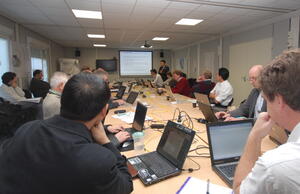Fuelling the fusion furnace
The fuelling experts from the ITER Organization and external advisors recently met in Cadarache to discuss still open issues of the ITER fuelling systems. One of the most important and urgent topics the workshop addressed was disruption mitigation.
Disruptions can cause significant electro-magnetic and thermal loads on the machine and its structure. They can also trigger runaway electrons which are lethal for most in-vessel components. A reliable disruption mitigation system for ITER is thus essential.
One mitigation system envisaged is the introduction of massive amounts (~500 g) of particles, helium or neon for example, into the plasma within 10 msec. "This is quite an engineering challenge," says So Mruyama, Leader of the ITER Fuelling Section. There are three possible candidates to achieve this, namely gas injection, pellet injection and beryllium injection, but all have to be massive! "These are all well known techniques, but none of them has yet been demonstrated on the ITER scale and environment!"
ITER will be the biggest fusion furnace ever built. Its fuelling system basically consists of a combination of two techniques: a gas injection system and a pellet injector. The gas injection system releases hydrogenic and impurity gases into the vacuum chamber allowing the plasma control during operation. At the divertor level of the ITER machine, gas injections will enhance radiative heat transfer in the divertor region by introducing impurity gases such as neon and argon into the plasma. Gas injection will also help to control plasma detachment resulting in significant heat loads to the divertor. "We have to avoid high peak heat loads to the targets," says So. "What we strive for is to prevent plasma re-attachment to divertor, otherwise the its heat load will be lethal for the divertor material."
The second fuelling system, the pellet injector, is mainly an ice maker—though one with a very high efficiency. An extruder punches out several-millimeter sized deuterium-tritium ice pellets within that are propelled by a gas gun up to 3600 km/h, fast enough to penetrate deep into the plasma core. The Oak Ridge National Laboratory, which is responsible of the procurement of ITER pellet injector, has developed a twin pellet extruder demo and successfully demonstrated continuous deuterium ice production in March 2008.
Pellet injection is the main tool to control the plasma density and it also seems to be a viable option to control edge localized modes (ELM), highly energetic outbursts in the plasma. Only, to shoot the frozen fuel to where it is needed, for example into the high energetic zone next to the inner wall of the vacuum chamber, the pellets have to fly around the plasma following a bended pipe. The "flight tube experiment" set up in Oak Ridge tries to find out the best ratio of maximum speed to mass loss. A R&D program is set up to further develop a pellet injector prototype, which consists of the extruder, a pneumatic gas gun accelerator, a propellant gas recirculation and a fuel recovery circuit.



